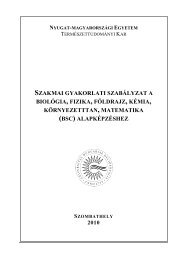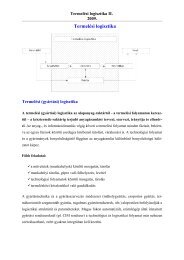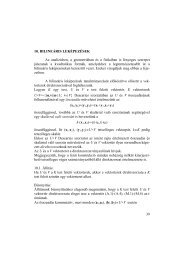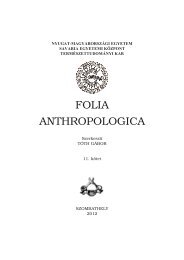You also want an ePaper? Increase the reach of your titles
YUMPU automatically turns print PDFs into web optimized ePapers that Google loves.
Folia Anthropologica 4; 43. (2006)<br />
THE IMPORTANCE OF ANTHROPOMETRY IN RESEARCH<br />
OF CRANIOFACIAL DISFIGUREMENTS<br />
Leslie G. Farkas<br />
Department of Plastic Surgery, The Hospital for Sick Children,<br />
Toronto, Ontario, Canada<br />
Quantitative analysis of the morphological changes of the craniofacial complex is essential for the<br />
successful surgical treatment. In order to determine the morphological changes appropriate anthropometric<br />
measurements are used. The successful surgical treatment requires precise anthropometric analysis of the<br />
face. For assessment of the degree of disfigurements the surgeon is using the required norms of the<br />
craniofacial complex. The sex and age of the patient should establish the proper time of the surgical<br />
intervention. At the present time with frequent migration of people the ethnic/racial origin of patients is<br />
essential to know. Evidently, in case of surgical intervention the craniofacial norms, listed in the national<br />
characteristics of the patient’s origin, must be used.<br />
The three dimensional character of the craniofacial complex requires in addition to the single linear<br />
measurements in the 6 regions of the craniofacial complex (forehead, face, orbits, nose, oral region and<br />
ears), also the knowledge of the value of relationships between them: the proportion indices. Areal<br />
proportions are informing us about the relationship of measurements within the individual regions of the<br />
craniofacial complex. The interareal proportion indices are revealing the relation quality between the<br />
measurements within two different regions. To bring about the determination of the appropriate quality<br />
(degree) of the craniofacial surface measurements for patients, normal values are required in all age<br />
groups and for all nations/races of patient, from childhood to adulthood. It is essential for surgical<br />
interventions of patients with disfigurement of the craniofacial complex.<br />
The maturation of the individual areas of the craniofacial complex is reached earlier in females than<br />
in males. At 15 years of age all anatomical points of the craniofacial complex are fully developed in<br />
males, which is finished by 14 years of age in females. Exception is the length of the ear (sa-sba), which is<br />
fully developed by age 12 years. The age of maturation is important, because a milder degree of disfigurement<br />
in early childhood (1-6 years of age) may correct itself and thus disappear by the age of maturation.<br />
The surgical correction of the craniofacial dismorphology of a patient demand appropriate anthropometric<br />
norms of the face and head of the healthy subjects. The race, nationality, sex and age of the patient<br />
would determine the way where to look for information requested. Thus, to find the most suitable method<br />
of the surgical intervention, precise results of the preoperative anthropometric analysis have to be<br />
ascertained. It means, the essential requirement is to possess the necessary scientific medical literature.<br />
A szerző címe:<br />
Dr. Leslie G. Farkas<br />
59 Claywood Road<br />
Toronto, ON<br />
M2N 2R3<br />
CANADA<br />
43
















